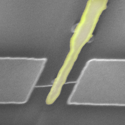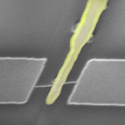Relaxing in a nanotube
How electrons scatter in a material strongly influences its transport characteristics and, by extension, its device applicability. Writing in Physical Review Letters, Yung-Fu Chen and coworkers from the University of Illinois and Michigan State University report measurements of the energy distribution of electrons in a carbon nanotube under nonequilibrium conditions. To accomplish this, the group studies the tunneling current in a nanotube connected to a metallic superconducting probe.
The authors find that electrons relax slowly as they move along the nanotube, i.e., a typical electron does not lose its energy over several microns. In addition, while the relaxation rate does depend on temperature, it appears to be independent of the end-to-end conductance values measured along the nanotube. These insights are valuable in the study of transport in one-dimensional systems such as Luttinger liquids, since carbon nanotubes, as opposed to previously studied metallic wires, are thought to be purely one dimensional. – Sami Mitra





